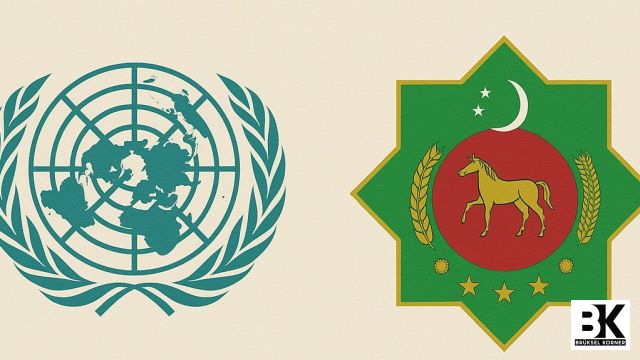A Path Forward: The Third UN Conference on LLDCs (5–8 August 2025, Awaza, Turkmenistan)
In an increasingly interconnected world, no nation should be held back by the accident of geography. Yet for the 32 landlocked developing countries (LLDCs), being cut off from direct access to the sea remains a formidable obstacle to economic integration, trade expansion, and sustainable development. High transport costs, transit delays, limited infrastructure, and external dependencies combine to isolate LLDCs from global markets, perpetuating cycles of poverty and underinvestment.

Recognizing this reality, the United Nations has, over the past two decades, taken decisive steps to bring the challenges of LLDCs to the forefront of international development policy. With the establishment of the UN Office of the High Representative for the Least Developed Countries, Landlocked Developing Countries and Small Island Developing States (UN-OHRLLS), and through a series of dedicated global conferences, the UN has championed the idea that geography must not dictate destiny.
This article traces the evolution of that journey — from the groundbreaking Almaty Conference in 2003, through Vienna in 2014, and now to the pivotal moment unfolding in Awaza, Turkmenistan in 2025. Each of these summits has marked a critical milestone in forging global partnerships, improving transit connectivity, and redefining the role of LLDCs in the global economy.
Turkmenistan, with its strategic location in Central Asia and its long-standing policy of neutrality, plays a key role in this story. Its decision to host the Third UN Conference on LLDCs is more than symbolic; it reflects a deep national commitment to fostering dialogue, promoting sustainable connectivity, and supporting the transformation of landlocked countries into land-linked nations.
It is our hope that this volume serves not only as a chronicle of these efforts, but also as a source of inspiration for the next decade of action. Because the future of LLDCs is not landlocked — it is open, dynamic, and interconnected, if we continue to build the partnerships that matter most.
Introduction
The international community has long recognized that geography can impose fundamental constraints on a country’s development. Among the starkest examples are landlocked developing countries — nations without direct access to the sea, surrounded by one or more neighbors. For these countries, trade routes are longer and more expensive, infrastructure is often inadequate, and the barriers to entering global markets are significantly higher.
Today, 32 countries fall into the LLDC category, spanning Africa, Asia, South America, and Eastern Europe. Together, they represent over 440 million people. While diverse in culture and context, these countries share common challenges: excessive transport costs, vulnerability to external shocks, and dependency on often fragile transit corridors. These constraints limit their ability to industrialize, diversify exports, attract investment, and fully participate in the global economy.
The UN’s response to these unique challenges began taking shape in the early 2000s, culminating in the first-ever global conference dedicated to LLDCs in 2003. Since then, the LLDC agenda has matured into a structured, decade-based approach, grounded in Programmes of Action that are collectively designed, internationally supported, and periodically reviewed.
This book aims to provide a comprehensive account of that journey. It explores the origins, milestones, and evolving goals of the UN Conferences on LLDCs — their impact on policy, infrastructure, trade facilitation, and economic transformation. But it also casts a forward-looking lens, examining how LLDCs can shape their futures through digital innovation, climate resilience, regional cooperation, and strategic diplomacy.
At the heart of this story lies Turkmenistan — a landlocked country that has emerged as a convener of ideas, a bridge between regions, and a firm advocate for international solidarity. Its hosting of the 2025 conference marks a moment of convergence between national leadership and global commitment. This is, in many ways, the right place and the right time to redefine what it means to be a landlocked developing country in the 21st century.
Chapter 1: The Challenge of Being Landlocked
The concept of being landlocked may seem like a simple geographic condition, but for the 32 landlocked developing countries (LLDCs), it represents a complex set of structural disadvantages that touch nearly every facet of national life. From higher trade costs to constrained industrial development, LLDCs face unique hurdles in their pursuit of economic growth and integration into the global economy.
At the most basic level, LLDCs lack direct access to seaports — the lifelines of global trade. As a result, they must rely on neighboring transit countries for import and export routes, often through underdeveloped or congested infrastructure. The dependency on external corridors introduces significant costs and vulnerabilities. According to UN data, LLDCs face transport and trade costs that are, on average, twice as high as those of their coastal counterparts. In some regions, landlocked exporters may wait up to three weeks to clear goods through border posts and reach international shipping terminals.
These delays and costs have cascading effects. They deter foreign direct investment, reduce competitiveness in export markets, and limit the scale and diversity of economic activities. Most LLDCs remain heavily dependent on a narrow range of primary commodities for export — minerals, agricultural products, or hydrocarbons — and struggle to attract the infrastructure investment necessary for economic transformation. In addition, many of them are situated in politically or economically unstable regions, which further complicates transit and trade logistics.
The development indicators paint a sobering picture. LLDCs represent approximately 7% of the global population, yet they account for less than 1% of global merchandise exports. Roughly 40% of LLDC populations live in slum-like conditions, and many face food insecurity, weak healthcare systems, and underfunded education sectors. Nine of the 15 lowest-ranked countries on the UN Human Development Index are landlocked, and in the wake of recent global crises — including the COVID-19 pandemic and geopolitical shocks — LLDCs have seen many of their modest development gains erode.
While some landlocked countries (such as Switzerland or Austria) have managed to prosper through high levels of regional integration and robust infrastructure, their cases are exceptional. For the majority of LLDCs — particularly in Sub-Saharan Africa, Central Asia, and parts of South America — the path to development remains strewn with logistical, economic, and institutional barriers. Simply put, geography has become a proxy for exclusion in the global economy.
Yet it is precisely this recognition that has galvanized international action. Since the early 2000s, the United Nations and its partners have made it clear that the world must not accept geography as destiny. The specific needs of LLDCs have been elevated to the highest levels of diplomatic attention, and a specialized development framework has emerged — one rooted in partnership, infrastructure investment, regional cooperation, and sustainable transit systems.
This chapter sets the stage for understanding why a landlocked status is not merely a matter of location, but of development justice. It also explains why the international community — led by the United Nations — has committed to a generational effort to unlock the potential of LLDCs through targeted policies, resources, and conferences of global scale.
Chapter 2: The UN and the LLDC Agenda
The recognition of Landlocked Developing Countries (LLDCs) as a distinct category within the international development landscape did not happen overnight. For decades, the challenges faced by landlocked nations were acknowledged in legal and trade documents — such as Article 125 of the 1982 United Nations Convention on the Law of the Sea, which affirms the right of access to and from the sea for landlocked states. However, these provisions were largely abstract, and LLDCs lacked a cohesive, actionable framework to address their economic and structural disadvantages.
This began to change in the late 1990s and early 2000s, when a growing body of economic analysis, coupled with diplomatic advocacy by LLDCs themselves, prompted the UN system to treat their situation as a special development case. A turning point came in 2001, when the UN General Assembly established the Office of the High Representative for the Least Developed Countries, Landlocked Developing Countries and Small Island Developing States (UN-OHRLLS). This office was tasked with raising awareness of the unique vulnerabilities of these three groups and ensuring that their voices were reflected in global policy processes.
UN-OHRLLS quickly became the institutional anchor for LLDC advocacy. Its mandate included coordinating international support, mobilizing resources, and serving as a platform for dialogue between LLDCs, their transit neighbors, and development partners. Crucially, the office also laid the groundwork for the first-ever global conference dedicated to LLDCs, which would take place in Almaty, Kazakhstan in 2003.
This marked the beginning of a decade-based, conference-led development framework for LLDCs. The approach was simple but ambitious: every ten years, a global conference would convene to assess progress, adopt a new Programme of Action, and issue political declarations aligning the global community with LLDC needs. Each Programme of Action would define priority areas — infrastructure, trade facilitation, transit policy, regional integration — and offer a roadmap for international cooperation.
The UN’s focus on LLDCs is grounded in both economic logic and human rights principles. From an economic standpoint, helping LLDCs integrate into global markets can boost regional stability, expand trade networks, and unlock underutilized resources. From a rights-based perspective, it is about equal opportunity and inclusion — ensuring that no country is left behind simply because it lacks a coastline.
Over time, the LLDC agenda has gained visibility and credibility. It has been mainstreamed into the Sustainable Development Goals (SDGs), with specific targets that emphasize inclusive trade, resilient infrastructure, and regional integration. LLDCs have also been recognized in major global frameworks such as the Addis Ababa Action Agenda on Financing for Development and the Paris Agreement on climate change.
Importantly, the LLDC agenda is not only about aid — it is about systemic change. The focus is on transforming LLDCs from passive recipients of development assistance into active participants in global trade, value chains, and regional diplomacy. The Programmes of Action are not legally binding, but they reflect a shared commitment by governments, multilateral institutions, and private sector actors to level the playing field.
In this evolving landscape, Turkmenistan has emerged as a particularly active and constructive partner. As a landlocked country in the heart of Central Asia, it has championed dialogue, infrastructure connectivity, and neutral diplomacy — values that align naturally with the LLDC agenda. Turkmenistan’s decision to host the third UN Conference on LLDCs in 2025 is both a diplomatic milestone and a signal of its intent to shape the future of regional development.
The following chapters will examine in detail the three UN Conferences on LLDCs — Almaty (2003), Vienna (2014), and Awaza (2025) — each representing a critical phase in the global effort to transform isolation into opportunity.
Chapter 3: The Almaty Breakthrough (2003)
The First United Nations Conference on Landlocked Developing Countries, held in Almaty, Kazakhstan on 28–29 August 2003, marked a watershed moment in international development diplomacy. For the first time in UN history, the collective needs and priorities of landlocked developing countries were addressed in a standalone, global platform. The conference was a response to years of mounting evidence and advocacy, which showed that landlockedness was not merely a geographic trait but a systemic barrier to sustainable development.
Convened under the theme “Addressing the Special Needs of Landlocked Developing Countries within a New Global Framework for Transit Transport Cooperation,” the Almaty Conference brought together LLDCs, transit countries, donor states, international organizations, and UN bodies. It was co-organized by the United Nations and the Government of Kazakhstan, which itself is the largest landlocked country in the world by area. The symbolism was potent: a landlocked country hosting a landmark event aimed at redefining the possibilities for others like it.
At the heart of the conference was the adoption of the Almaty Programme of Action (APoA) — a ten-year development framework with five strategic priority areas:
Transit Policy and Regulatory Frameworks: This area called for simplification and harmonization of customs procedures, removal of non-physical barriers, and implementation of bilateral and multilateral transit agreements.
Infrastructure Development and Maintenance: The APoA emphasized investment in transport infrastructure — roads, railways, inland waterways, pipelines, and dry ports — both within LLDCs and across key corridors with their transit neighbors.
International Trade and Trade Facilitation: The programme sought to integrate LLDCs into the global trading system by improving their access to markets, streamlining logistics, and reducing trade transaction costs.
International Support Measures: Recognizing that LLDCs and transit countries lacked sufficient resources, the APoA called for increased technical and financial assistance from donor countries and international financial institutions.
Implementation and Follow-up: The final priority area established mechanisms to monitor progress, report on implementation, and ensure that the commitments made in Almaty would be upheld over time.
The Almaty Ministerial Declaration, adopted alongside the APoA, expressed the collective political will of participating states to commit to these principles and to build a global partnership in support of LLDCs. Importantly, it also framed the agenda not as a North–South dichotomy, but as a triangular cooperation model — among LLDCs, their neighboring transit states, and the broader international community.
The conference emphasized the concept of shared responsibility: while LLDCs had to pursue reforms and improve governance, their transit neighbors needed to facilitate movement of goods and services, and donors needed to support both with resources and expertise. This triangular approach laid the foundation for a cooperative spirit that would define LLDC-focused multilateralism going forward.
Impact and Legacy of Almaty
The Almaty Conference and Programme of Action were widely hailed as a success — not because they immediately eliminated the structural problems facing LLDCs, but because they established a global consensus around the nature of the problem and what needed to be done. It was the first time that a dedicated international action plan addressed infrastructure, policy, and institutional obstacles to transit-based development in a coordinated way.
In the decade that followed (2003–2013), LLDCs and their development partners began to integrate APoA priorities into national development plans and regional strategies. While implementation was uneven, progress was made in several areas:
Transit corridor projects were launched or accelerated in Africa, Asia, and Latin America.
Many LLDCs improved their customs and trade facilitation procedures, laying the groundwork for eventual participation in the WTO’s Trade Facilitation Agreement.
Donor funding for infrastructure saw a modest increase, particularly through multilateral banks and South-South cooperation.
Still, challenges remained. A 10-year review of the APoA revealed that LLDCs continued to suffer from high trade costs, underdeveloped logistics systems, and limited integration into global markets. It became clear that a second-generation agenda was needed — one that would expand the scope beyond transit to include economic transformation, resilience, and digital connectivity.
That realization would guide the preparation for the Second UN Conference on LLDCs, held in 2014 in Vienna — the subject of the next chapter.
Chapter 4: From Almaty to Vienna (2014)
The decade following the Almaty Conference brought both progress and new challenges for Landlocked Developing Countries. While many LLDCs had made strides in improving customs procedures, enhancing regional transport infrastructure, and securing modest donor support, their structural vulnerabilities remained deeply entrenched. The global financial crisis of 2008, the fluctuating prices of key export commodities, and the increasing impacts of climate change further exposed their fragility. It was clear that the development model launched in Almaty needed to evolve.
In response, the United Nations convened the Second UN Conference on Landlocked Developing Countries in Vienna, Austria, from 3 to 5 November 2014. Hosted by a transit country — Austria — and organized in cooperation with UN-OHRLLS, the conference was attended by over 1,000 participants, including heads of state, ministers, development partners, UN agencies, and civil society organizations. The event was not only a stocktaking of the Almaty Programme of Action (APoA), but a strategic pivot toward a broader and more holistic development agenda for LLDCs.
The result was the adoption of the Vienna Programme of Action for Landlocked Developing Countries for the Decade 2014–2024 (VPoA), along with the Vienna Declaration. Together, they represented a recalibration of priorities — a shift from focusing almost exclusively on transit transport to recognizing that LLDC development also requires economic transformation, regional integration, technological innovation, and resilience building.
Six Priority Areas of the Vienna Programme of Action
The Vienna PoA identified six interrelated priority areas, each designed to address the multifaceted challenges faced by LLDCs:
Fundamental Transit Policy Issues
LLDCs continued to face excessive documentation, border delays, and unpredictable fees. The VPoA urged countries to implement modern customs procedures, harmonize cross-border regulations, and establish efficient and secure transit systems using digital technologies such as electronic cargo tracking and one-stop border posts.
Infrastructure Development and Maintenance
Recognizing that poor-quality infrastructure remained a key barrier to competitiveness, the VPoA called for large-scale investments in transport, energy, and ICT infrastructure. It also emphasized regional corridor development — from the Abidjan–Lagos corridor in West Africa to the Central Asia Regional Economic Cooperation (CAREC) corridors.
International Trade and Trade Facilitation
The VPoA linked LLDC development more directly to global trade integration. It strongly supported implementation of the WTO Trade Facilitation Agreement (TFA) and promoted initiatives to diversify exports, reduce trade costs, and enhance logistics services.
Regional Integration and Cooperation
The VPoA encouraged LLDCs to deepen their participation in regional economic communities, harmonize transport agreements, and promote regional value chains. LLDCs were urged to take a proactive role in shaping regional trade and infrastructure projects, rather than merely serving as transit spaces.
Structural Economic Transformation
One of the most significant shifts from the Almaty agenda, this priority highlighted the need for LLDCs to move beyond raw commodity exports and develop value-added sectors — manufacturing, agro-processing, and services. Investment promotion, business environment reforms, and innovation policies were promoted.
Means of Implementation
The VPoA recognized that none of these goals could be achieved without financial support, capacity building, and technology transfer. It called for enhanced partnerships with development partners, multilateral banks, and the private sector. The emphasis was placed on South-South and triangular cooperation, and better alignment with the 2030 Agenda for Sustainable Development.
Political and Institutional Commitments
The Vienna Declaration, issued alongside the Programme of Action, reaffirmed the commitment of the international community to “leave no LLDC behind.” It emphasized mutual accountability, urging both LLDCs and transit countries to implement reforms, while calling on donors and international institutions to prioritize LLDC needs in their financing, aid, and technical assistance programs.
The declaration also established stronger monitoring mechanisms, with periodic progress reviews, annual LLDC ministerial meetings at the UN General Assembly, and the integration of LLDC indicators into broader SDG monitoring frameworks. The idea was to avoid the pitfalls of the past — where implementation lagged and coordination was uneven — by building a more results-oriented accountability structure.
Early Results and Midterm Review
The early years of the VPoA saw some encouraging developments:
Several LLDCs ratified and began implementing the WTO Trade Facilitation Agreement, which came into force in 2017.
Regional projects such as the Lapis Lazuli Corridor (linking Afghanistan to Turkmenistan and further west) and the Kazungula Bridge (connecting Botswana and Zambia) were launched.
Many LLDCs began incorporating digital tools to monitor cargo, automate customs, and reduce paperwork.
However, by the time of the High-Level Midterm Review in 2019, progress was deemed uneven and too slow. The review acknowledged improvements in infrastructure and policy but also underscored persistent gaps in trade competitiveness, export diversification, and financing. The global economic disruptions caused by COVID-19 shortly thereafter further threatened LLDC progress, reinforcing the need for a more resilient and forward-looking approach.
This set the stage for the Third UN Conference on LLDCs, to be hosted by Turkmenistan in 2025 — a moment that would bring the LLDC agenda back to Central Asia and offer a new opportunity to reinvigorate global partnerships.
Chapter 5: Turkmenistan’s Rising Role
Turkmenistan, a landlocked country in the heart of Central Asia, has emerged over the past two decades as a strategic regional connector and a diplomatic bridge-builder — a nation whose geographic realities have sharpened its focus on infrastructure development, neutral foreign policy, and multilateral cooperation. Its active engagement in the Landlocked Developing Countries (LLDCs) agenda is both a reflection of its national interests and a broader commitment to international solidarity and sustainable connectivity.
Geopolitical and Strategic Context
Bordered by Kazakhstan, Uzbekistan, Afghanistan, Iran, and the Caspian Sea, Turkmenistan occupies a critical geo-economic corridor between East and West, North and South. Although technically not landlocked (due to its access to the Caspian Sea), it is considered a de facto LLDC in global development frameworks because of the absence of navigable sea routes that connect to global oceans.
Turkmenistan’s challenges mirror those of other LLDCs: the need for efficient transport links, the high cost of trade transit, and the imperative of regional cooperation. However, rather than remain constrained by these limitations, Turkmenistan has invested heavily in infrastructure modernization and international transport corridors — positioning itself as a logistics hub for Central Asia, the Caucasus, and the Middle East.
Infrastructure and Connectivity Vision
At the heart of Turkmenistan’s economic policy is the development of international transport and energy corridors. The country has launched or participated in numerous initiatives that align directly with LLDC priorities:
The Lapis Lazuli Corridor, inaugurated in 2018, connects Afghanistan, Turkmenistan, Azerbaijan, Georgia, and Turkey. It reduces shipment times between Central and South Asia to Europe and is a model of regional cooperation between LLDCs and transit states.
The Turkmenbashi International Seaport, on the Caspian Sea, was reconstructed and expanded at a cost of over $1.5 billion. It now serves as a vital multimodal logistics hub for landlocked countries in Central Asia, linking rail and road routes with maritime trade toward the Caucasus and Europe.
Turkmenistan is a founding member of SPECA (Special Programme for the Economies of Central Asia), a UN-backed initiative focused on regional connectivity, trade facilitation, and transit harmonization.
The country plays a leading role in the Central Asia–Middle East–South Asia transit vision, linking the Chabahar Port in Iran with roads and railways extending across Turkmenistan and further into Uzbekistan, Afghanistan, and beyond.
These efforts reflect a consistent national strategy: to convert geographic remoteness into geopolitical advantage by becoming an essential transit node for surrounding countries. In doing so, Turkmenistan is also helping other LLDCs — particularly Afghanistan and Uzbekistan — to access global markets through shorter, more efficient trade routes.
Foreign Policy of Neutrality and Multilateralism
Turkmenistan’s permanent neutrality, recognized by a UN General Assembly resolution in 1995, underpins its foreign policy and makes it a trusted convener of international dialogue. This status allows the country to engage across geopolitical divides and act as a stabilizing force in a region marked by historic rivalries and emerging partnerships.
Its multilateral diplomacy emphasizes economic cooperation, energy diplomacy, and transport integration — pillars that directly align with the LLDC agenda. Over the years, Turkmenistan has hosted and co-sponsored numerous UN resolutions, regional forums, and international summits on transit, sustainable transport, and landlocked development.
Notably, Turkmenistan has championed UN General Assembly resolutions on “the role of transport and transit corridors in ensuring international cooperation for sustainable development,” which echo the themes of the Vienna Programme of Action. These resolutions, introduced biennially, underscore the country’s advocacy for corridor-based development, a concept central to modern LLDC strategies.
Road to Awaza 2025
Perhaps the clearest demonstration of Turkmenistan’s leadership in the LLDC space is its decision to host the Third United Nations Conference on Landlocked Developing Countries, scheduled for 5–8 August 2025 in Awaza, a national tourism and conference zone on the Caspian coast. This is a landmark moment — not only is it the first LLDC conference held in Central Asia, but it is also a rare instance where a country hosts a global development summit focused on its own regional and economic realities.
In offering to host the conference, Turkmenistan signaled its intent to shape the global conversation on connectivity, partnership, and resilience. The government has already undertaken extensive preparatory diplomacy, including regional consultations, infrastructure showcases, and bilateral briefings with UN-OHRLLS and LLDC member states. The conference venue, Awaza, symbolizes a vision of transformation: from landlocked to land-linked, from isolated to integrated.
By positioning itself not only as a participant but as a facilitator of global LLDC cooperation, Turkmenistan stands to make a lasting contribution — one that elevates both its national interests and the shared aspirations of all landlocked developing countries.
Chapter 6: The Road to Awaza (2025)
The lead-up to the Third United Nations Conference on Landlocked Developing Countries (LLDC3) has been shaped by a global environment of profound transformation and uncertainty. From the economic aftershocks of the COVID-19 pandemic to intensifying climate impacts, geopolitical tensions, and disruptions in global supply chains, the challenges facing LLDCs have not diminished — they have deepened. Against this backdrop, the 2025 conference in Awaza, Turkmenistan, emerges as a timely and necessary recalibration of the international community’s approach to the needs of landlocked nations.
The Decision to Host in Awaza
In April 2025, the United Nations General Assembly, by consensus, adopted Resolution A/RES/79/279, officially designating Awaza as the host of LLDC3, with the full support of UN-OHRLLS and over 50 co-sponsoring countries. The choice of Turkmenistan as host was both symbolic and strategic. For the first time, the LLDC summit would be held in Central Asia, a region where many LLDCs converge, and where efforts toward transit corridor integration and regional cooperation are already well underway.
Awaza, situated on the eastern shore of the Caspian Sea, was chosen not only for its modern facilities, but also for its emblematic value. A showcase of Turkmenistan’s infrastructure ambitions, the Awaza zone is designed to serve as a hub for conferences, tourism, and transport development. Hosting LLDC3 here highlights the intersection of vision, geography, and diplomacy, placing the LLDC agenda at the heart of global conversation once again.
Preparations and Diplomatic Engagement
In the months preceding the conference, Turkmenistan engaged in an active phase of multilateral and regional diplomacy, hosting preparatory meetings and aligning priorities with LLDC stakeholders. Among the most significant events were:
Regional preparatory consultations in Africa (hosted by Zambia), Asia and Europe (co-hosted by Mongolia and Kazakhstan), and Latin America (with Bolivia and Paraguay), where LLDCs reviewed their progress on the Vienna Programme of Action and identified emerging priorities for the next decade.
Coordination with UN-OHRLLS, the UN Department of Economic and Social Affairs (DESA), and regional commissions (ESCAP, UNECE, ECA) to ensure that the conference themes would reflect both global development trends and localized needs.
Engagement with the private sector, think tanks, and multilateral development banks, signaling a shift toward a broader stakeholder approach in developing the next Programme of Action.
Derya Soysal











Yorum Yazın